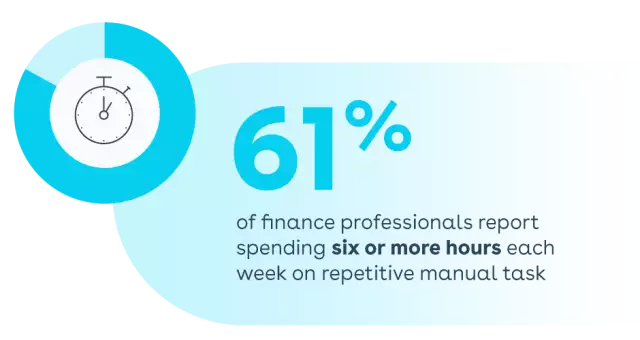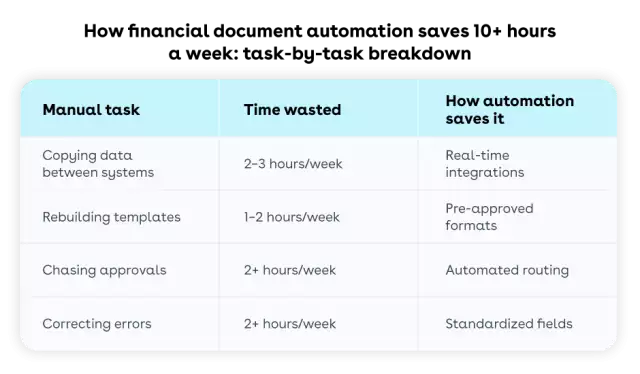
How finance teams can save 10+ hours a week
What is financial document automation?
Financial document automation is the process of using technology to streamline the creation, management, and delivery of essential financial documents at scale. It replaces manual workflows with automated systems that pull real-time data from platforms like CRMs or ERPs to create critical financial documents like invoices, quotes, agreements, financial summaries, and more.
In practice, this means finance teams no longer need to build each document from scratch, copy and paste data between systems, or wait on slow approval cycles. Instead, they can generate bulk invoices, customize budget forecasts, and deliver accurate financial summaries to stakeholders in minutes rather than hours.
Pre-approved templates ensure consistency and compliance, while automation reduces turnaround time, prevents errors, and eliminates the back-and-forth that often slows down document workflows.
For finance leaders, document automation isn’t just a tool—it’s a time-saving strategy. By automating repetitive document tasks, teams can reclaim 10 or more hours each week. Teams can use that time to focus on strategic planning, forecasting, and working across departments.
Automation also supports better communication across departments by making financial information faster to generate, easier to access, and more reliable. Whether you're managing recurring billing, financial reporting, or high-volume quote requests, automation ensures finance teams move faster and make smarter decisions.
Modern finance teams are expected to operate with speed, precision, and control. Financial document automation provides a scalable solution that meets these demands—whether you're standardizing monthly reporting, streamlining billing cycles, or supporting faster quote-to-cash processes. With automation in place, your finance function becomes more agile, responsive, and aligned with the pace of modern business.
Why does financial document automation matter?
Succeeding in today’s fast-paced business environment requires finance teams to operate with efficiency, accuracy, and strict adherence to complex compliance mandates. Yet many organizations still rely on outdated manual document workflows that that slow everything down and introduce unnecessary risk.
Document automation for finance helps recover those lost hours by transforming how documents are created, reviewed, and delivered. It directly addresses common time-wasters, including:
- Manual workflows: Finance teams often generate documents like quotes, budgets, reports, and invoices by manually copying and pasting information from multiple systems. This slows output, drains productivity, and creates inconsistent results.
- Human error: Manual data entry and formatting mistakes can lead to incorrect billing, internal confusion, or regulatory missteps—damaging both trust and compliance.
- Approval bottlenecks: When document review and approval processes are informal or disconnected, delays become inevitable—especially with multiple stakeholders involved.
- Slow billing cycles: Manually creating, reviewing, and sending invoices delays billing and puts cash flow and revenue recognition at risk.
- Compliance risk: Financial documents must meet strict regulatory standards. Without automation, it’s harder to enforce consistency and maintain audit-ready records.
These issues aren’t just inconvenient—they’re costly. In fact, 61% of finance professionals report spending six or more hours each week on repetitive manual tasks. Add in time lost to approvals, corrections, and reformatting, and the total easily surpasses 10 hours.

Document automation for finance reduces the burden of manual work by integrating with core systems like CRMs, ERPs, or accounting systems to automatically generate critical documents with speed and accuracy. Automated routing and approval workflows eliminate bottlenecks, while standardized templates ensure consistency and regulatory compliance.
Failure to implement financial document automation can have serious consequences—from lost revenue opportunities and delayed financial forecasts to increased audit risk. Errors in documentation or missed deadlines can erode client trust and open the door to compliance violations. For finance leaders, automating document generation is a critical step toward improved accuracy, agility, and scalability.

What are the benefits of automating financial documents?
Financial document automation empowers finance teams to streamline workflows across core functions like billing, quoting, compliance, and stakeholder communications. Following are seven essential benefits—along with their implications for finance leaders.
Improved efficiency. Automating financial document workflows reduces the time spent on repetitive, manual tasks. Finance teams no longer have to hunt for the latest version of a template or re-enter data into multiple systems. This boost in efficiency frees up capacity for more strategic activities like financial planning and analysis.
Accuracy and consistency. Automating financial document generation ensures documents are always created with the correct data, formatting, and branding. By using standardized templates and pre-populated fields, finance teams can minimize human error and maintain consistency across internal reports, external communications, and regulatory documents.
- Improved forecasting. Quote automation allows finance teams to standardize pricing, discounting, and contract terms through pre-approved templates. This not only ensures accuracy but also improves alignment between finance and sales. By automating quoting, organizations can gain better visibility into upcoming revenue, improve forecasting precision, and help leaders plan with greater confidence.
- Faster billing and invoicing. Manual billing processes are time-consuming and error prone. With automated billing, finance teams can reduce manual data entry by pulling real-time information from CRMs or ERPs into invoices. This speeds up the quote-to-cash cycle and accelerates cash flow—which is especially valuable in subscription-based and high-volume billing environments.
- Lower compliance risk. In highly regulated industries like healthcare and financial services, documentation errors can lead to fines, penalties, and reputational damage. With workflow automation, every step—from generation to approval—is logged with an audit trail. Approval chains, locked templates, and consistent formatting reduce risk while supporting compliance with evolving regulations.
- Scalable operations without extra headcount. As document volume increases, finance process automation enables teams to scale without hiring. Batch sends, automated routing, and integrated eSignature tools allow finance teams to handle high document volumes with minimal effort. This saves time, boosts team morale, and ensures operational efficiency even during peak cycles like quarter-end close.
- Enhanced experience. Consistent, timely, and professional communication strengthens trust with both customers and internal stakeholders. With financial document automation, documents are delivered faster, more accurately, and often with self-service access—enhancing satisfaction, transparency and responsiveness across the board.
What types of financial documents can be automated?
Financial document automation offers exceptional flexibility, enabling finance teams to streamline a wide range of routine and complex document types. Whether internal-facing or external, transactional or strategic, nearly every document in a finance team’s workflow can benefit from automation.
Examples of documents that can be automated include:
- Invoices
- Billing statements
- Quotes
- Purchase orders
- Credit and debit memos
- Account summaries
- Payment reminders
- Budget reports
- Forecasting reports
- Tax documents (e.g., 1099s, VAT reports)
- Financial statements (P&L, balance sheet, cash flow)
- Loan agreements
- Audit reports
- Performance summaries
- Compliance disclosures
- Pricing change notifications
- Terms and conditions (T&C) updates
- eSignature-ready contracts
- Renewal notifications
- Reimbursement requests
- Regulatory filings
No matter the industry, finance teams are expected to work faster, more accurately, and in full alignment with governance and compliance standards. Financial document automation helps meet those demands by making document workflows smarter, more scalable, and far less manual.
What are the key features for financial document automation?
Choosing the right financial document automation software is essential to improving operational efficiency, reducing risk, and generating timely, accurate finance documentation. But with so many solutions on the market, making a smart choice can be difficult.
The most effective document automation software includes an array of must-have features designed to support high-volume, high-accuracy document workflows. Look for a document generation solution that includes the following capabilities:
- Document creation: Robust tools for generating documents from templates ensure accuracy and consistency across quotes, invoices, financial summaries, and more.
- Data integration (CRM, ERP, etc.): Seamless integration with your preferred system of record enables real-time data to flow directly into documents—eliminating manual entry and reducing errors.
- Template flexibility: Look for support across multiple formats, including Microsoft Word, Excel, and PDF. The ability to deliver documents across a variety of channels—such as email, portals, or internal apps—gives teams the flexibility to meet business and stakeholder needs.
- Conditional logic: Intelligent rules allow documents to adapt based on variables like customer type, product line, business unit, or region—ensuring that each output is personalized and relevant.
- Bulk generation: High-volume capabilities allow teams to generate and deliver thousands of documents at once—ideal for recurring billing, quarterly reporting, or compliance communications.
- Branding and customization: Ensure every document reflects your brand consistently with customizable layouts, fonts, logos, colors, and messaging.
- Workflow automation: Automate review, approval, and routing processes to reduce bottlenecks and keep documents moving efficiently through the organization.
- Notifications and tracking: Real-time alerts visibility into document status—including who has the document and when it’s opened, reviewed, or signed—support faster decisions and stronger accountability.
- eSignature integration: Built-in electronic signature capabilities accelerate document execution, enhance security, and eliminate delays from manual signing processes.
- Compliance and audit support: Features like approval chains, version control, and audit trails support compliance in highly regulated environments like finance and healthcare.
- Central document repository: A secure, searchable repository ensures that finance teams can quickly access both current and archived documents for audits, reporting, or internal reference.
When evaluating your options, it’s important to choose a partner that understands the complexities finance teams face. Conga’s robust Document Automation solutions include all these features and more—empowering finance teams to simplify document-heavy processes, ensure compliance, and scale efficiently.
Whether you're automating quotes, invoices, or financial summaries, Conga delivers the agility and control today’s finance teams need to succeed.
Reclaim time with Document Automation
See how Conga helps finance teams save 10+ hours each week with smart, scalable automation. Visit our Document Automation page to learn more.



